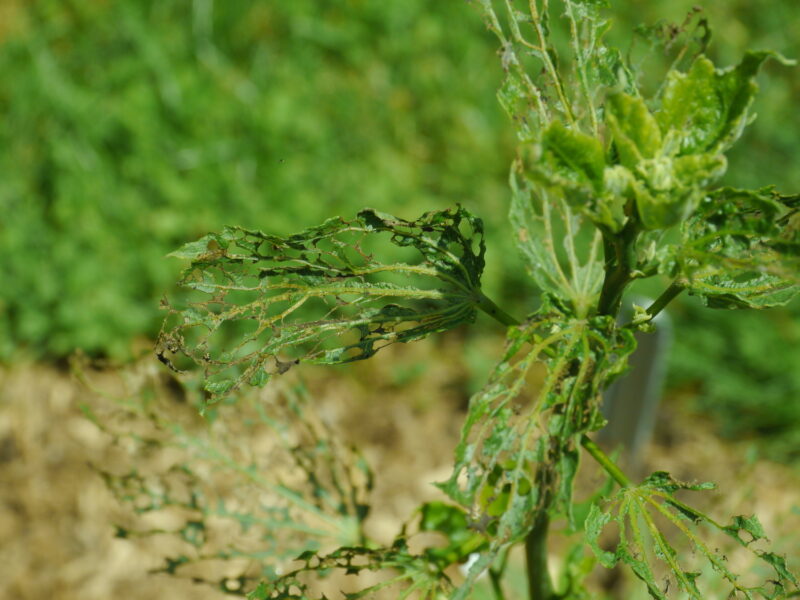

In just a week as we turned from late May to early June the daytime temperatures went from the 60s up into the 80s. And as we continue with our look at garden insects, it’s important to know that as the temperatures outdoors increase so does the reproduction rate of most garden insects. So now it’s even more important to be vigilant.
It’s also important to keep in mind that as the temperature increases, many insecticides, even organic ones, can have toxic effects on plants. Insecticides that contain petroleum distillates and oils can cause what we call phytotoxicity as it gets warmer. So while ultrafine horticultural oils can now be the insecticides of choice, beware of this when the temperature goes close to and above 85 degrees.
Now we move from the sucking insects like the aphids and scales into group No. 2, the chewing insects. These still have six legs as they are true insects, but they tend to emerge a bit later than the suckers. Ah, you say, but something was eating the foliage on my plants in May. How can that be? Probably because the holes and chewed leaf margins you were seeing were from slugs or snails — and not insects. Slugs usually do their damage from dusk till the sun gets higher in the sky, and they often leave a telltale slime trail. Insecticides should not be used on them.
These slimy creatures can be picked off and dropped into a container of soapy water or fed to chickens or ducks, or you can apply a snail bait. There are both organic and chemical slug baits, but in the vegetable garden you probably want to stay with the organic types. Both work by relaxing the slugs’ bodies so they can’t crawl back down into the soil or under leaves and duff. As the sun rises it dries them out, and the work is done.
There are a number of home remedies for snails and slugs. These include copper strips (that they won’t cross), wide lines of wood ashes, coffee grounds, and pie plates sunken slightly into the ground then filled with beer. The slugs go for the beer and drown. Don’t waste your good beer — the slugs are not picky.
In the ornamental garden the most common chewing insects are found on roses. These include the Japanese beetle, the Asiatic beetle and the rose chafer. These three have a life cycle that involves the adults dropping to the ground as they mature and usually laying their eggs in turf. As the eggs develop into grubs in the fall and continue to mature in the early spring, they feed on the roots of the grass plants before emerging as flying insects that then attack your roses and other plants including grapes and some trees.
Obviously, picking the beetles off the plants and dropping them into a jar or can of soapy water is one way of reducing or eliminating them. A number of chemical sprays can be used such as Sevin, but this one is highly toxic to bees and is nonselective. Like malathion it tends to kill every insect, good and bad, that it comes into contact with. Spot sprays, pointed directly at the beetle and not covering the entire plant will work as well. Pyrethrin sprays work well as a spot spray, but the pyrethrin is nonselective as well, and the warmer it gets the less effective it gets.
Bt, or Bacillus thuringiensis, can also be effective and is organic, but over the years many beetles have or seem to have developed a resistance to it. You also need to spray the entire plant, and the beetle needs to ingest the Bt for it to be effective. This means that some chewing damage will take place. Bt can also be applied around your plants later in the summer, and as it moves into the soil it can attack the larval stages of the beetles in late summer and late spring.
I have issues with beetles on my rose of Sharon and perennial hibiscus so several times a day I put a few drops of Joy detergent in a small plastic cup, add water, then walk around the garden tapping stems and flowers as the beetles drop into the soapy solution.
Yet another option is Spinosad, which is a bacterial product that’s organic and OMRI approved for organic gardening. This material works on contact but should be applied over the entire plant. Spinosad is also said to be safe around bees as long as you follow the label instructions.
Next there are grasshoppers and locusts, both of which are chewers. Grasshoppers rarely do much damage in ornamental plants, but locusts do and can. While both are mostly nuisance insects, the periodic locusts (noted by the number of years in their life cycle like the 17-year locust) can do damage by their mass numbers and their feeding but they also oviposit (lay eggs) at the growing tips of many trees. This results in dieback of the twigs. While it does result in minor damage, most trees recover.
In the vegetable garden the worst chewer is the flea beetle. This small black beetle leaves irregular-shaped holes in the leaves and can often make a leaf look like it’s been hit with a BB gun. This beetle can be found on radish, broccoli, cabbage, eggplant, turnips, peppers, tomatoes, potatoes, spinach and melons. You can read more about this beetle here: tinyurl.com/4x4386j4.
One of the most effective ways to keep this beetle off of your plants is to cover them with row covers, which are thin spun fabrics that allow light to penetrate but not the bugs. Timing for this method is critical though because you don’t want to exclude pollinators when the plants are in flower, but you do need to exclude the flea beetles when they are in feeding mode and when laying eggs.
One of the most infamous beetles that East End gardeners may be familiar with is the Colorado potato beetle. It was ubiquitous at our local farms in the days when potato farming was the major agricultural endeavor out here, and yes, it was a leaf-eater. So, what better way to get rid of it than to add a pesticide to the soil that was then absorbed through the potato plant roots making the entire plant toxic and nearly fatal to the beetle? Except for two things.
The first was that over the years the beetle became nearly immune to the pesticide used against it, and then we found that the pesticide called Temik, with the active ingredient of aldicarb, did not bind to soil particles as expected since we have very sandy soils and instead leached into our groundwater. The result was that many of our private and municipal water wells were contaminated and shut down.
The beetle still shows up in our gardens, but again, it’s easy to remove by hand and there are some effective pesticides that control this beetle without damaging the human species.
Then there’s the emerald ash borer, a beetle whose larva bores into the ash tree trunk and kills it. It’s been a very effective borer/beetle, and now most of the ash trees on Long Island and throughout the East are dead.
Tomato growers are familiar with the tomato hornworm, which turns into the very large five-spotted hawkmoth or sphinx moth. But left alone on a nice tomato plant it can devour the plant in just days. No sprays or chemicals needed though. Just put on a glove, remove the hornworm and put it down the toilet or in the garbage.
The last chewer to consider is now called, to be politically correct, the spongy moth. This was previously known as the gypsy moth. The moth’s caterpillar stage feeds primarily on shade trees like oaks, and in bad outbreaks it can decimate a forest in just a few years. Thankfully, there are biological controls, and some have been distributed into the wild where they are doing a great job of minimizing the gypsy moth damage, especially in rainy years when the fungus replicates fairly fast.
It seems that for just about every plant we like or must grow there is something that wants to feed on it, be it a caterpillar or beetle. Apple and pear growers have to deal with the codling moth, whose larvae drill into the fruits where they feed. Grape growers must deal with the grape vine beetle, which can also show up in our yards, but its damage is somewhat limited by vigilant vintners.
And if all this hasn’t freaked you out, there are the diseases that these chewers transmit. Spotted and striped cucumber beetles transmit bacterial diseases to squash and other cucurbits. The elm bark beetle transmits Dutch elm disease. Grasshoppers are known to transmit several viruses.
What’s a gardener to do? DON’T PANIC. When you can, use disease- and virus-resistant plants and seed. When you see a suspicious insect, first identify it and only then take the least environmentally consequential action, like just picking off the hornworm or dropping the Japanese beetle into soapy water. Read up, and of course, please, keep growing.
GARDEN NOTES
We’re many weeks away from the emergence of the Japanese beetles, but when they do show up I see the pheromone (sex) traps set up in way too many gardens. Once again: They do not work.
The sex attractant that these traps use to lure the beetles into the traps inevitably bring in the beetles from all around your neighborhood, and many if not most don’t end up in the traps. Learn the other ways to manage this insect. These yellow traps with bags hanging from them that use a sex lure are not the solution.
Cornell Cooperative Extension could come under the very heavy ax of our federal effort to reduce the federal budget. We owe so very much to the men and women who work for CE and support our farms, fisheries and gardens. Please write to your congressmen and ask that these cuts should not take place. If you want to know why, please ask me. If you know already, then write, call or email your congressman.
 More Posts from Andrew Messinger
More Posts from Andrew Messinger